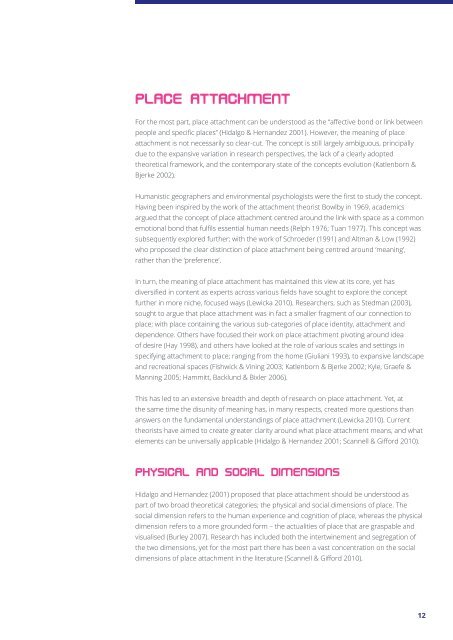Exploring the Role of 'Visual Catalysts' on Influencing People's Attraction and Use of Place
Undergraduate Thesis // Keegan Lovell // Bachelor of Landscape Architecure // UNSW 2016
Undergraduate Thesis // Keegan Lovell // Bachelor of Landscape Architecure // UNSW 2016
You also want an ePaper? Increase the reach of your titles
YUMPU automatically turns print PDFs into web optimized ePapers that Google loves.
PLACE ATTACHMENT<br />
For <str<strong>on</strong>g>the</str<strong>on</strong>g> most part, place attachment can be understood as <str<strong>on</strong>g>the</str<strong>on</strong>g> “affective b<strong>on</strong>d or link between<br />
people <strong>and</strong> specific places” (Hidalgo & Hern<strong>and</strong>ez 2001). However, <str<strong>on</strong>g>the</str<strong>on</strong>g> meaning <str<strong>on</strong>g>of</str<strong>on</strong>g> place<br />
attachment is not necessarily so clear-cut. The c<strong>on</strong>cept is still largely ambiguous, principally<br />
due to <str<strong>on</strong>g>the</str<strong>on</strong>g> expansive variati<strong>on</strong> in research perspectives, <str<strong>on</strong>g>the</str<strong>on</strong>g> lack <str<strong>on</strong>g>of</str<strong>on</strong>g> a clearly adopted<br />
<str<strong>on</strong>g>the</str<strong>on</strong>g>oretical framework, <strong>and</strong> <str<strong>on</strong>g>the</str<strong>on</strong>g> c<strong>on</strong>temporary state <str<strong>on</strong>g>of</str<strong>on</strong>g> <str<strong>on</strong>g>the</str<strong>on</strong>g> c<strong>on</strong>cepts evoluti<strong>on</strong> (Katlenborn &<br />
Bjerke 2002).<br />
Humanistic geographers <strong>and</strong> envir<strong>on</strong>mental psychologists were <str<strong>on</strong>g>the</str<strong>on</strong>g> first to study <str<strong>on</strong>g>the</str<strong>on</strong>g> c<strong>on</strong>cept.<br />
Having been inspired by <str<strong>on</strong>g>the</str<strong>on</strong>g> work <str<strong>on</strong>g>of</str<strong>on</strong>g> <str<strong>on</strong>g>the</str<strong>on</strong>g> attachment <str<strong>on</strong>g>the</str<strong>on</strong>g>orist Bowlby in 1969, academics<br />
argued that <str<strong>on</strong>g>the</str<strong>on</strong>g> c<strong>on</strong>cept <str<strong>on</strong>g>of</str<strong>on</strong>g> place attachment centred around <str<strong>on</strong>g>the</str<strong>on</strong>g> link with space as a comm<strong>on</strong><br />
emoti<strong>on</strong>al b<strong>on</strong>d that fulfils essential human needs (Relph 1976; Tuan 1977). This c<strong>on</strong>cept was<br />
subsequently explored fur<str<strong>on</strong>g>the</str<strong>on</strong>g>r; with <str<strong>on</strong>g>the</str<strong>on</strong>g> work <str<strong>on</strong>g>of</str<strong>on</strong>g> Schroeder (1991) <strong>and</strong> Altman & Low (1992)<br />
who proposed <str<strong>on</strong>g>the</str<strong>on</strong>g> clear distincti<strong>on</strong> <str<strong>on</strong>g>of</str<strong>on</strong>g> place attachment being centred around ‘meaning’,<br />
ra<str<strong>on</strong>g>the</str<strong>on</strong>g>r than <str<strong>on</strong>g>the</str<strong>on</strong>g> ‘preference’.<br />
In turn, <str<strong>on</strong>g>the</str<strong>on</strong>g> meaning <str<strong>on</strong>g>of</str<strong>on</strong>g> place attachment has maintained this view at its core, yet has<br />
diversified in c<strong>on</strong>tent as experts across various fields have sought to explore <str<strong>on</strong>g>the</str<strong>on</strong>g> c<strong>on</strong>cept<br />
fur<str<strong>on</strong>g>the</str<strong>on</strong>g>r in more niche, focused ways (Lewicka 2010). Researchers, such as Stedman (2003),<br />
sought to argue that place attachment was in fact a smaller fragment <str<strong>on</strong>g>of</str<strong>on</strong>g> our c<strong>on</strong>necti<strong>on</strong> to<br />
place; with place c<strong>on</strong>taining <str<strong>on</strong>g>the</str<strong>on</strong>g> various sub-categories <str<strong>on</strong>g>of</str<strong>on</strong>g> place identity, attachment <strong>and</strong><br />
dependence. O<str<strong>on</strong>g>the</str<strong>on</strong>g>rs have focused <str<strong>on</strong>g>the</str<strong>on</strong>g>ir work <strong>on</strong> place attachment pivoting around idea<br />
<str<strong>on</strong>g>of</str<strong>on</strong>g> desire (Hay 1998), <strong>and</strong> o<str<strong>on</strong>g>the</str<strong>on</strong>g>rs have looked at <str<strong>on</strong>g>the</str<strong>on</strong>g> role <str<strong>on</strong>g>of</str<strong>on</strong>g> various scales <strong>and</strong> settings in<br />
specifying attachment to place; ranging from <str<strong>on</strong>g>the</str<strong>on</strong>g> home (Giuliani 1993), to expansive l<strong>and</strong>scape<br />
<strong>and</strong> recreati<strong>on</strong>al spaces (Fishwick & Vining 2003; Katlenborn & Bjerke 2002; Kyle, Graefe &<br />
Manning 2005; Hammitt, Backlund & Bixler 2006).<br />
This has led to an extensive breadth <strong>and</strong> depth <str<strong>on</strong>g>of</str<strong>on</strong>g> research <strong>on</strong> place attachment. Yet, at<br />
<str<strong>on</strong>g>the</str<strong>on</strong>g> same time <str<strong>on</strong>g>the</str<strong>on</strong>g> disunity <str<strong>on</strong>g>of</str<strong>on</strong>g> meaning has, in many respects, created more questi<strong>on</strong>s than<br />
answers <strong>on</strong> <str<strong>on</strong>g>the</str<strong>on</strong>g> fundamental underst<strong>and</strong>ings <str<strong>on</strong>g>of</str<strong>on</strong>g> place attachment (Lewicka 2010). Current<br />
<str<strong>on</strong>g>the</str<strong>on</strong>g>orists have aimed to create greater clarity around what place attachment means, <strong>and</strong> what<br />
elements can be universally applicable (Hidalgo & Hern<strong>and</strong>ez 2001; Scannell & Gifford 2010).<br />
PHYSICAL AND SOCIAL DIMENSIONS<br />
Hidalgo <strong>and</strong> Hern<strong>and</strong>ez (2001) proposed that place attachment should be understood as<br />
part <str<strong>on</strong>g>of</str<strong>on</strong>g> two broad <str<strong>on</strong>g>the</str<strong>on</strong>g>oretical categories; <str<strong>on</strong>g>the</str<strong>on</strong>g> physical <strong>and</strong> social dimensi<strong>on</strong>s <str<strong>on</strong>g>of</str<strong>on</strong>g> place. The<br />
social dimensi<strong>on</strong> refers to <str<strong>on</strong>g>the</str<strong>on</strong>g> human experience <strong>and</strong> cogniti<strong>on</strong> <str<strong>on</strong>g>of</str<strong>on</strong>g> place, whereas <str<strong>on</strong>g>the</str<strong>on</strong>g> physical<br />
dimensi<strong>on</strong> refers to a more grounded form – <str<strong>on</strong>g>the</str<strong>on</strong>g> actualities <str<strong>on</strong>g>of</str<strong>on</strong>g> place that are graspable <strong>and</strong><br />
visualised (Burley 2007). Research has included both <str<strong>on</strong>g>the</str<strong>on</strong>g> intertwinement <strong>and</strong> segregati<strong>on</strong> <str<strong>on</strong>g>of</str<strong>on</strong>g><br />
<str<strong>on</strong>g>the</str<strong>on</strong>g> two dimensi<strong>on</strong>s, yet for <str<strong>on</strong>g>the</str<strong>on</strong>g> most part <str<strong>on</strong>g>the</str<strong>on</strong>g>re has been a vast c<strong>on</strong>centrati<strong>on</strong> <strong>on</strong> <str<strong>on</strong>g>the</str<strong>on</strong>g> social<br />
dimensi<strong>on</strong>s <str<strong>on</strong>g>of</str<strong>on</strong>g> place attachment in <str<strong>on</strong>g>the</str<strong>on</strong>g> literature (Scannell & Gifford 2010).<br />
12


